Domestic post-war aircraft guns caliber 23 mm. Part II
In the mid-fifties, there was a need to increase the rate of fire aviation guns. The constant increase in the speeds of fighters and bombers required an increase in the volume of the second salvo of the gun in order to increase the probability of hitting the target. However, existing designs and technologies have reached the limit of their capabilities. Further development of classic automatic cannons could not significantly improve their performance.
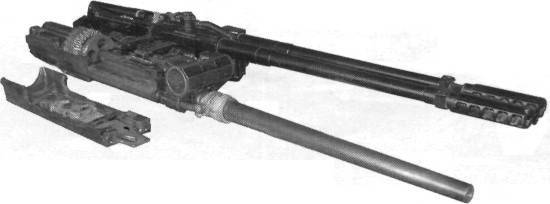
To overcome this situation, several original ideas were proposed. For example, OKB-16 engineers, headed by A.A. Richter proposed to develop not only a new rapid-fire gun, but also an original ammunition for it, which would take into account new principles of operation. weapons. During the development of the project of a promising gun wore the designation 261P.
In order to increase the rate of fire, it was proposed to abandon the use of automatic "classic" design in favor of the so-called. revolving system. This means that a rotating drum with several chambers had to interact with the barrel of the gun. Such a system made it possible to speed up the reloading process and thereby increase the rate of fire of the weapon. However, the original design of the automation needed special ammunition.
Especially for the 261P gun was developed ammunition 23x260 mm. Its distinctive feature was a long cylindrical sleeve in which the shell was completely recessed. The projectile weighed 513 g and was equipped with a thick-walled 255 mass. The projectile for the new ammunition was made on the basis of the existing design, but it had less weight - 173 g. In addition, to ensure the operability of the gun, it was necessary to strengthen the embedding of the projectile in the sleeve. The original projectile for the new gun was of great interest from a technical point of view, but some of its features became the object of criticism. There was too much weight ammunition guns, as well as some loss of existing weapons in the power of the projectile. Nevertheless, the work on the project 261P continued.
The 261P cannon of the Richter design was quite compact: its total length did not exceed 1470 mm. In this case, the total length of the barrel and chamber were slightly less than the total length of the gun. The weight of the finished gun reached 58 kg. A rotary drum with four chamber chambers was located behind the breech block. Instead of mechanical drummers, an electric ignition system was used. Automatic guns worked by the energy of powder gases. A characteristic feature of the gun was the use of three independent gas engines at once, each of which was responsible for the operation of its mechanisms.
The first gas engine was used to send a projectile into the drum chamber. The tape with ammunition was fed to the middle part of the gun, in front of the chamber. When fired, the powder gases pushed the special piston of the first gas engine, which sent a new projectile into the free upper chamber. When sending, the projectile moved at a speed of about 25 m / s. Such a process of breeding was called the cast or shock. It should be noted, it was the method of filing that affected the design of the munition, in particular, the embedding of the projectile in the sleeve.
The second gas engine, after ramming the projectile, was supposed to turn the drum on 90 °. Rotating, the drum handed the projectile to the barrel, after which a shot was made. Next, the chamber with the spent cartridge was fed to the extraction line. With the help of the third gas engine, the liner was literally blown out of the chamber at a speed of 40 m / s.
The 261P gun barrel was made according to the original scheme and received a progressive cut. Before getting into the barrel, the projectile had time to gain some speed inside the liner, which is why he hit the rifle and increased barrel wear. To ensure the required survivability of the gun received a liner - a replaceable bore. When worn, this part could be replaced with a new one. The inner surface of the liner had a variable slope. In the breech section, the rifling slopes were gentle, and in the muzzle section, the normal slope.
The drum chart used in the project could provide the highest rate of fire. For example, developed by A.A. Richter heavy machine gun, built on such a system, in theory, could make up to 5 thousand shots per minute. The rate of fire of the 261P gun was half as much - the main reason for this was the thermal load on the barrel. Nevertheless, even at this rate of fire, the second salvo of the 261 cannon reached 7,2 kg against 3 kg for HP-23 or 4,2 kg for AM-23.
The automatic gun 261P did not receive a unique assessment. She had a high rate of fire and a second salvo, several times higher than that of existing 23-mm guns. At the same time, the development of A.A. Richter was difficult to manufacture and operate, and also used a special projectile, which limited the allowable ammunition. The specific characteristics of the gun affected her fate. In 1967, its creators received the State Prize, but the gun itself was never officially accepted for service. The Ministry of Defense document from 1963 of the year allowed the continued production and operation of guns.
However, the gun 261P under the designation P-23 could become a weapon of combat bombers. In 1959, the gun set DK-20 was created, which was proposed for installation on the Tu-22 aircraft. It was originally intended to equip this bomber with AM-23 guns, however A.A. Richter and A.E. Nudelman could convince A.N. Tupolev in the need to use their tools. Installation DK-20 was equipped with electro-hydraulic drives and remote control using radar and television sights.
In 1973, the KB of precision engineering (the former OKB-16) developed a new modification of the gun called the P-23M “Catch”. It differed from the base case with some technical and technological modifications. The upgraded gun was proposed to be installed on combat spacecraft. Information on the manufacture or testing tools "buckshot" is missing.
The P-23 automatic cannon was used only on long-range Tu-22 bombers. The shortcomings and complexity of the gun did not allow it to be used on other types of aircraft. The total number of guns released did not exceed 500-550 units.
GSH-23
According to some information, one of the most active critics of the complex and expensive P-23 cannon was VP Tula, TsKB-14 employee. Gryazev. It should be noted that Tula designers did not limit themselves to stating the shortcomings of the development of A.A. Richter, and offered their own version of improving the characteristics of aircraft guns. To meet the requirements of the military, it was decided to make a double-barreled gun.
In developing new weapons, Tula designers under the leadership of V.P. Gryazev and A.G. Shipunova used so-called. Gusta scheme: this means that the gun has two barrels connected to each other through a synchronization mechanism. The action of such automation is based on the use of recoil energy in the short course of the trunk. The movement of one of the barrels activates the mechanisms of the gun, resulting in a recharge of the second barrel. When fired from the second barrel, the first one is prepared for shooting. Such a system allows to increase the rate of fire by about half compared to single-barrel systems with a short barrel stroke, slightly increasing the size and weight of the weapon. In addition, alternate firing of the two barrels allows to reduce thermal loads and ensure their acceptable cooling.
The gun GSH-23 received two barrel caliber 23 mm, connected by a special synchronization mechanism. To simplify the design and preserve acceptable dimensions, several gun systems interacted with two barrels at once. Such ammunition supply and ejection mechanisms and the pyrorecharge system made it possible to keep the weight of the gun at the level of 50 kg with the total length of 1,54 m. The ammunition should use the 23х115 mm projectile intended for use with an electric fuse. Feed ribbons with ammunition could be carried out from any side.
With a comparative design complexity, the GSH-23 gun had rather high characteristics. The initial velocity of the projectile exceeded 750 m / s, the effective firing range - 1,8 km. The original two-barrel automatics made it possible to bring the rate of fire to 2500 rounds per minute. It should be noted that during the further development of the project, this parameter has grown significantly.
The automatic cannon GSH-23 has become a weapon of combat helicopters Mi-24VP. On these machines, the gun is used in conjunction with a mobile cannon installation LUP-24. A cannon with 460 ammunition shells allows you to effectively attack manpower and lightly armored vehicles at distances up to 1,5-2 km. The ability to aim the gun in the vertical and horizontal planes increases the flexibility of its application.
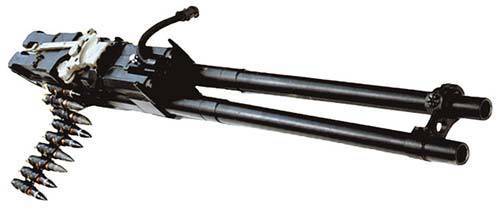
A further development of the GSH-23 gun was its modification of the GSH-23L. It differs from the basic version only in the presence of localizers intended for the directed removal of powder gases. Localizers allow you to divert the powder gases from the air intakes of the aircraft, as well as slightly reduce the impact. The first aircraft on which the GSH-23L gun was installed was the MiG-21 fighter. This instrument was equipped with several modifications of the MiG-21. In the future, GL-23Sh guns were equipped with fighters and bombers of several models, including the MiG-23, Su-15ТМ, Su-17М, Tu-22М, Tu-95 and others. The gun GSH-23L is used in the suspension containers UPK-23-250, SPPU-22 and VSPU-36. The latter was developed specifically for the deck attack aircraft Yak-38 and Yak-38М.
The automatic cannon GSH-23 was put into service in the 1965 year, and after a few years it became one of the most common aircraft guns in the USSR Air Force. The production of guns of this model is still ongoing at the Kovrov Plant. Degtyarev.
GSH-6-23
The second way to increase the rate of fire of aircraft cannons, which Tula gunsmiths have been working on since the early sixties, was a system with a rotating barrel unit. Such weapons were more difficult in comparison with those built on the basis of the Gast scheme, however, it could have many times higher rate of fire. Designers under the leadership of V.P. Gryazev and A.G. Shipunova simultaneously developed two new automatic guns AO-18 and AO-19 of caliber 30 and 23 mm, respectively.
The basis of the design of the gun AO-19 consists of six barrels with their own valves, assembled into a single mobile unit. The block of barrels and bolts can rotate around its axis. The rotation of the barrel unit and the operation of other automation elements are carried out at the expense of the energy of the powder gases discharged from the barrels during firing. The electric system is used for fire control, the gun ammunition is the 23х115 mm projectile with electric ignition.
The initial promotion of the barrel assembly is carried out by a gas piston-type pyrostarter using PPL squibs. The pyrostarter cassette contains 10 squibs. During the rotation of the block, all six gates consistently recharge the barrels, and after the shot, the spent cartridges are removed and discarded. This way of working allows you to reduce the time between individual shots and thereby increase the firing rate of the gun, because at the moment of firing from one barrel the next one turns out to be completely ready for firing.
Due to the complex system and the use of several barrels, the AO-19 cannon turned out to be quite heavy - its weight was 73 kg. The total length of the weapon is 1,4 m, the maximum width is 243 mm. The initial velocity of the high-explosive fragmentation projectile or armor-piercing incendiary with a tracer was equal to 715 m / s. Thanks to the use of a rotating block of barrels, the AO-19 gun became the most rapid-fire domestic aviation weapon - the rate of fire reached 9 thousand gunshots per minute. The maximum queue length in order to avoid overheating of the structure is limited to 250-300 shots.
Serial production of AO-19 guns began in the 1972 year. Two years later, the gun was adopted under the name of GSH-6-23 (9А-620). The GSH-6-23 guns were installed on MiG-31 fighters (260 rounds of ammunition) and Su-24 front bomber (400 shells). In addition, the SPSP-6 suspended cannon container with the GSH-6-23 and 260 ammunition of shells was developed.
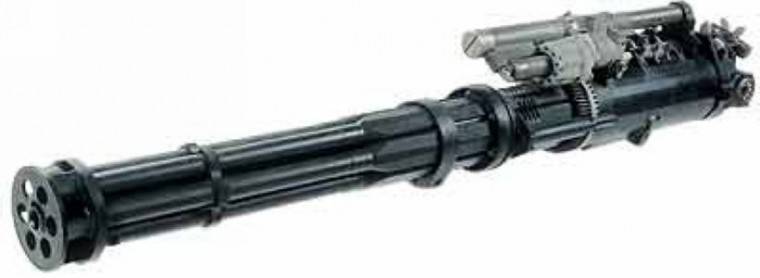
A little later, a modification of the cannon called the GSH-6-23M was created. With the help of some design changes, the rate of fire was brought to 10 thousand shots per minute. According to some reports, during the tests, it was possible to achieve a rate of fire up to 11,5-12 thousand shots. This gun was installed on Su-24M bombers, ammunition is 500 shells.
The gun GSH-6-23 was the latest domestic aviation gun caliber 23 mm. The development of aviation has once again led to the fact that the caliber of existing automatic guns was not sufficient to combat modern and promising aircraft or ground targets. In the future, the development of small-caliber artillery for aircraft went the way of creating guns caliber 30 mm.
Based on:
http://airwar.ru/
http://airpages.ru/
http://museum-arms.ru/
http://russianarms.mybb.ru/
http://zid.ru/
Shirokorad A. B. History aviation weapons. - Mn .: Harvest, 1999
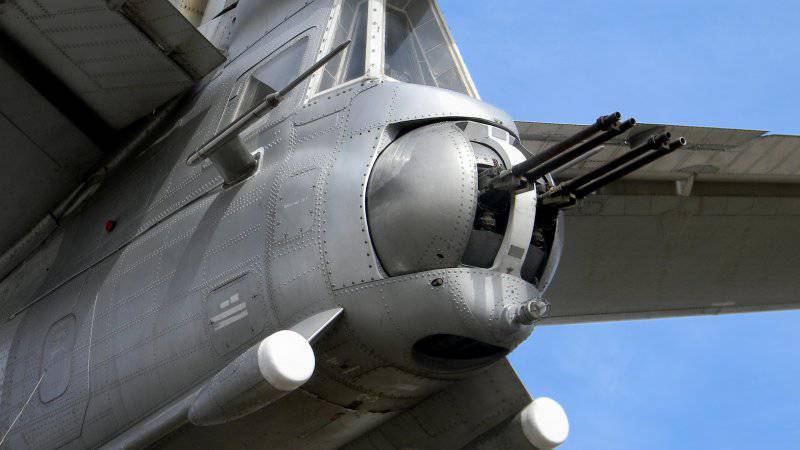
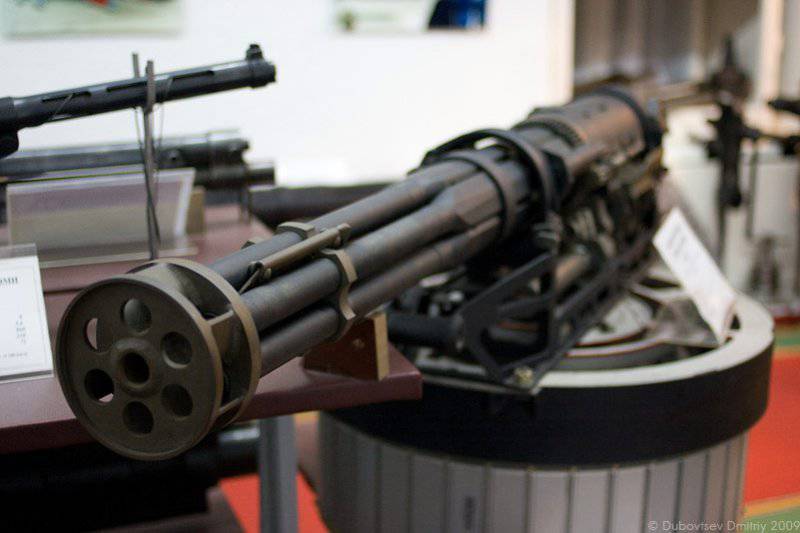
Information